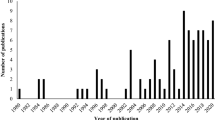Abstract
Data from camera traps that record the time of day at which photographs are taken are used widely to study daily activity patterns of photographed species. It is often of interest to compare activity patterns, for example, between males and females of a species or between a predator and a prey species. In this article we propose that the similarity between two activity patterns may be quantified by a measure of the extent to which the patterns overlap. Several methods of estimating this overlap measure are described and their comparative performance for activity data is investigated in a simulation study. The methods are illustrated by comparing activity patterns of three sympatric felid species using data from camera traps in Kerinci Seblat National Park, Sumatra.
Similar content being viewed by others
References
Ahmad, I. A. (1980a), “Nonparametric Estimation of an Affinity Measure Between Two Absolutely Continuous Distributions With Hypothesis Testing Applications,” Annals of the Institute of Statistical Mathematics, 32, 223–240.
— (1980b), “Nonparametric Estimation of Matusita’s Measure of Affinity Between Absolutely Continuous Distributions,” Annals of the Institute of Statistical Mathematics, 32, 241–245.
Batschelet, E. (1981), Circular Statistics in Biology, New York: Academic Press.
Clemons, T. E., and Bradley, E. L. (2000), “A Nonparametric Measure of the Overlapping Coefficient,” Computational Statistics and Data Analysis, 34, 51–61. Erratum: 36 (2002), 243.
Davis, D. D. (1962), “Mammals of the Lowland Rain-Forest of North Borneo,” Bulletin of the Singapore Natural History Museum, 31, 1–129.
Devroye, L. (1987), A Course in Density Estimation, Boston: Birkhäuser.
Di Bitetti, M. S., Paviolo, A., and De Angelo, C. (2006), “Density, Habitat Use and Activity Patterns of Ocelots (Leopardus pardalis) in the Atlantic Forest of Misiones, Argentina,” Journal of Zoology, 270, 153–163.
Fernández-Durán, J. J. (2004), “Circular Distributions Based on Nonnegative Trigonometric Sums,” Biometrics, 60, 499–503.
Ferreira, J. T. A. S., Juárez, M. A., and Steel, M. F. (2008), “Directional Log-Spline Distributions,” Bayesian Analysis, 3, 1–19.
Fisher, N. I. (1993), Statistical Analysis of Circular Data, Cambridge: Cambridge University Press.
Hurlbert, S. H. (1978), “The Measurement of Niche Overlap and Some Relatives,” Ecology, 59, 67–77.
Jácomo, A. T. A., Silveira, L., and Diniz-Filho, J. A. F. (2004), “Niche Separation Between the Maned Wolf (Chrysocyon brachyurus), the Crab-Eating Fox (Dusicyon thous) and the Hoary Fox (Dusicyon vetulus) in Central Brazil,” Journal of Zoology, 262, 99–106.
Jammalamadaka, S., and SenGupta, A. (2001), Topics in Circular Statistics, Singapore: World Scientific.
Karanth, K. U., and Sunquist, M. E. (1995), “Prey Selection by Tiger, Leopard and Dhole in Tropical Forests,” Journal of Animal Ecology, 64, 439–450.
Linkie, M., Borysiewicz, R. S., Dinata, Y., Nugroho, A., Achmad Haidir, I., Ridout, M. S., Leader-Williams, N., and Morgan, B. J. T. (2008), “Predicting the Spatio-Temporal Patterns of Tiger and Their Prey Across a Primary-Disturbed Forest Landscape in Sumatra,” unpublished manuscript.
Matusita, K. (1955), “Decision Rules, Based on the Distance, for Problems of Fit, Two Samples, and Estimation,” Annals of Mathematical Statistics, 26, 631–640.
Morisita, M. (1959), “Measuring Interspecific Association and Similarity Between Communities,” Memoirs of the Faculty of Science of Kyushu Univeristy, Series E, Biology, 3, 65–80.
Mulekar, M. S., and Mishra, S. N. (2000), “Confidence Interval Estimation of Overlap: Equal Means Case,” Computational Statistics and Data Analysis, 34, 121–137.
Nowell, K., and Jackson, P. (1996), Wild Cats—Status Survey and Conservation Action Plan, Gland, Switzerland: IUCN.
Rabinowitz, A. R., Andau, P., and Chai, P. P. K. (1987), “The Clouded Leopard in Malaysian Borneo,” Oryx, 21, 107–111.
Rychlik, L. (2005), “Overlap of Temporal Niches Among Four Sympatric Species of Shrews,” Acta Theriologica, 50, 175–188.
Schmid, F., and Schmidt, A. (2006), “Nonparametric Estimation of the Coefficient of Overlapping—Theory and Empirical Application,” Computational Statistics and Data Analysis, 50, 1583–1596.
Silverman, B. (1986), Density Estimation for Statistics and Data Analysis, New York: Chapman & Hall.
Slobodchikoff, C. N., and Schulz, W. C. (1980), “Measures of Niche Overlap,” Ecology, 61, 1051–1055.
Taylor, C. C. (2008), “Automatic Bandwidth Selection for Circular Density Estimation,” Computational Statistics and Data Analysis, 52, 3493–3500.
Wand, M. P., and Jones, M. C. (2005), Kernel Smoothing, London: Chapman & Hall.
Weckel, M., Giuliano, W., and Silver, S. (2006), “Jaguar (Panthera onca), Feeding Ecology: Distribution of Predator and Prey Through Time and Space,” Journal of Zoology, 270, 25–30.
Weitzman, M. S. (1970), “Measure of the Overlap of Income Distribution of White and Negro Families in the United States,” Technical Report No. 22, U.S. Department of Commerce, Bureau of the Census, Washington, DC.
Author information
Authors and Affiliations
Corresponding author
Rights and permissions
About this article
Cite this article
Ridout, M.S., Linkie, M. Estimating overlap of daily activity patterns from camera trap data. JABES 14, 322–337 (2009). https://doi.org/10.1198/jabes.2009.08038
Received:
Revised:
Issue Date:
DOI: https://doi.org/10.1198/jabes.2009.08038




